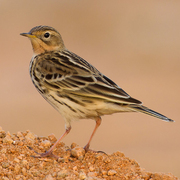Red-throated Pipit
Anthus
cervinus
Passeriformes
Members of this diverse group make up more than half of the bird species worldwide. Most are small. However their brains are relatively large and their learning abilities are greater than those of most other birds. Passerine birds are divided into two suborders, the suboscines and the oscines. Oscines are capable of more complex song, and are considered the true songbirds. In Washington, the tyrant flycatchers are the only suboscines; the remaining 27 families are oscines.
Motacillidae
The wagtails and pipits are small to medium-sized open-country ground-dwellers. Pipits are found worldwide, but wagtails are generally restricted to the Old World. Wagtails are often brightly colored with high-contrast patterns, and pipits are typically cryptically colored and patterned. Wagtails are sexually dimorphic: males and females have different plumage. Pipits are generally not sexually dimorphic, that is, males and females look alike. Wagtails and most pipits bob or wag their tails and bob their heads as they walk along the ground. Most are long-distance migrants. They eat primarily insects and other invertebrates, which they take from the ground, but they also eat seeds and fruit. They are monogamous, and both parents help tend the young.
General Description
One record, from San Juan Island (San Juan County) in September 1979.





